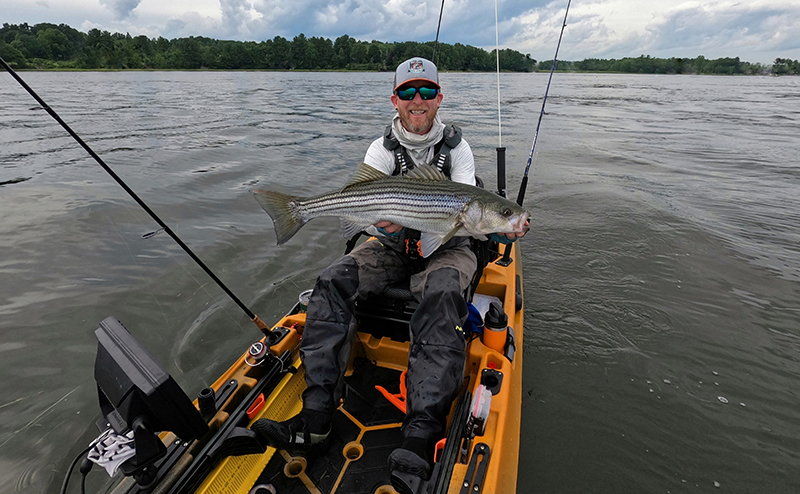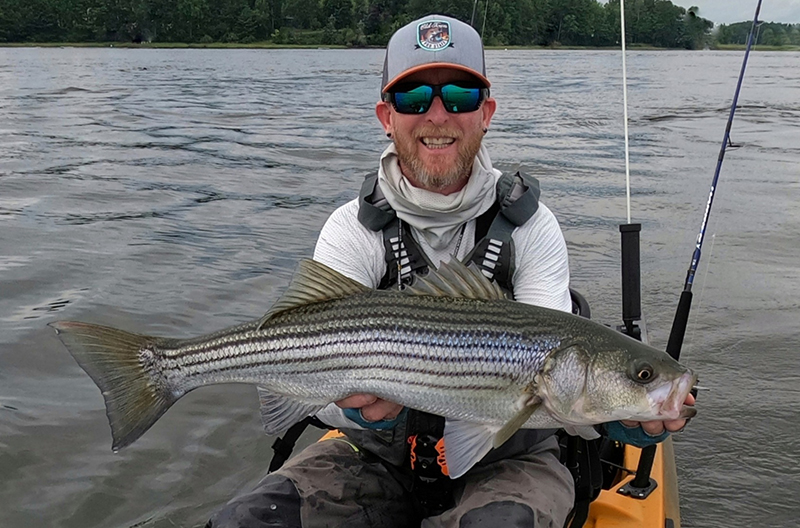Kayak Fishing Estuaries For Striped Bass
By: Tim Moore, Pro Staff
At 6,000+ acres, New Hampshire’s Great Bay is the second largest inland estuary on the east coast. It sits 10 miles inland of the Atlantic Ocean and is fed by the Piscataqua River, which with an average of 4MPH current, is said to be the third fastest tidal river in North America. It is considered by many anglers, especially kayak anglers, to be one of New Hampshire’s best striped bass fishing locations. I make much of my living there guiding kayak fishing trips for striped bass in the spring and summer months and “The Bay,” as locals refer to it, usually never fails to live up to its reputation. Great Bay estuary is not unique in its population of striped bass though. Striped bass can be found in every estuary along their migration route at some point. Knowing when and where to safely target them from a kayak in those estuaries is the key.
Most estuaries along the northeastern Atlantic coast see large tidal swings, with Great Bay seeing an average of around 8-feet difference from high to low tide. In the spring, the outgoing tide is most often the preferred tide to fish for stripers in Great Bay. We see an average 8-degree increase in water temperature from high to low tide. This spike in temperature increases striped bass feeding activity. As summer settles in and the average water temperature rises, the incoming tide will become the preferred tide, as bass will take advantage of cooler incoming water. Early mornings and cloudy days when there is less sun can also be productive, regardless of time of year. Later in the summer, I never discount a first-light high tide, as there is almost sure to be some fish cruising into the upper river and lower estuary to feed on bait species, such as fall-back river herring, that are more abundant there than outside the estuary.

As kayak anglers, we don’t have the luxury of firing up the engine and speeding off to another location several miles away. Scouting and taking note of key areas, even when the fishing isn’t prime, can be crucial. At low tide, note the location of exposed boulders and rock piles situated in usually heavy current, especially those adjacent to river mouths. At high tide these rocks will be submerged, with as much as 8-feet of water over them, and bigger stripers will use them as a place to wait for unsuspecting prey to swim past. Kayaks are great for getting in around the shallow rocks where boats can’t always go. Cast your lure of choice just beyond these rocks and retrieve it back over them but be careful not to drift your kayak directly over the rocks or you will spook the fish.
Dense flocks of terns or gulls diving into the water for bait almost always indicates a school of striped bass below. A handy tool for distant surface action is a pair of binoculars. Sometimes, bait will move into water as shallow as a foot deep. You’ll see the birds diving on the bait and make your way over there, only to find that there are no stripers there. Using binoculars to scan the water line for tell-tale splashes of stripers feeding from below, or not, can save you a ton of time and effort. There’s nothing worse than making your way a mile or so for diving birds, only to find the birds were only ambushing bait in super shallow water, and then to turn around and see fish jumping where you just came from. If you do plan to chase birds, be prepared to do a lot of paddling, pedaling, or motoring, because some days the fish may not stay in one place. Try to stay ahead of the school, but by all means don’t paddle directly into the middle of it or you will spook the fish. Stay on the edges of the school and cast into it if you can.

Stripers love structure. Rocks, rock piles, and rocky drop offs in current are favorite places for stripers to sit and wait for bait to wash over them. These are excellent places to do the same to striped bass. The Sportsman AutoPilot kayaks are incredibly effective for fishing stripers on structure, as the motor and ability to Spot Lock on the edges of submerged structure can easily double your catch. In swift current, drift speeds can be fast, and your drifts will be short. Being able to slow or stop your drift will give you time to really dissect an aera and prevent you from repeatedly drifting over the fish you are targeting. If you’re pedaling a PDL, try going out and around the area where the fish are when you reset your drift to avoid blowing out the fish. If you’re paddling, well…eat your Wheaties, but don’t let the extra work keep you off the water. Most of us, even if we rarely paddle our kayaks anymore, began in paddle kayaks and did quite well.
Fishing estuaries in a kayak is a labor of love. There is consistent fish presence, but weather can have a dramatic affect on the presence of striped bass. Cold fronts can shut fish off in a matter of hours, heat waves can push larger fish out to the ocean, and heavy rains will lower the salinity and dirty the water to the point that stripers vacate all together. That said, there is usually good access and pretty consistent action, especially if you put your time in to learn an area. Take advantage of your local kayak fishing community. Fishing is always more fun with friends, and two anglers are more effective at finding fish than one. Be safe, always wear your PFD, and have fun.
Tim Moore is a full-time professional fishing guide in New Hampshire and a member of the Old Town Canoes and Kayaks pro staff. He owns and operates Tim Moore Outdoors, LLC. He is also the producer of TMO Fishing on YouTube and the Hooked with TMO Fishing Podcast. Visit www.TimMooreOutdoors.com for more information.






